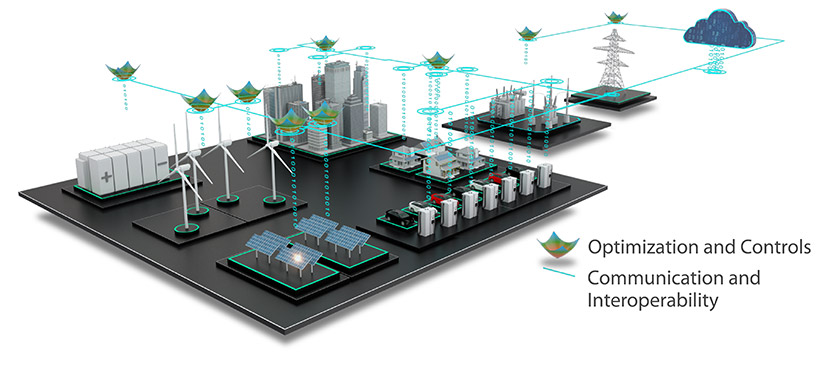Autonomous Energy Systems
Autonomous energy systems (AES) provide intelligent and robust solutions for operating highly electrified, heterogeneous energy systems.

Energy systems have become increasingly heterogeneous due to the proliferation of solar, wind, energy storage, electric vehicles, and building automations. Advanced grid configurations incorporating distributed generation and storage present communications, control, and coordination challenges. NLR created the concept of AES and conducted fundamental research work to design intelligent and robust solutions for operating highly electrified, heterogeneous energy systems.
Reimagining Optimization and Control of Future Energy Systems
Empowering Distributed Energy Resources
AES addresses technical challenges in coordinating large numbers of distributed energy resources and the deluge of data that come from these systems. AES provides:
- Efficient and cost-effective approaches to streamline the use of variable renewable generation and innovative technologies
- Real-time operations to balance load/demand and generation/supply every second and make best use of asynchronous data and control to accommodate changing conditions and delays in communications
- Robust tolerance to disturbances, faults, outages, and failures in both cyber and physical networks
- Interoperability with the integration of decisions, devices, platforms, and data with the aid of standard-based protocols
- Scalability to control hundreds of millions of energy resources across the grid, renewables, storage, mobility, buildings, inverters, and microcontrollers—from communities to neighborhoods to regions.
NLR has validated AES technologies for a variety of applications both in the laboratory and through small real-world demonstrations. We have partnered with utilities, land developers, municipalities, and cities to improve existing and build new energy systems for neighborhoods, military installations, and tribal lands. Now, NLR is taking the next step through partnerships—public and private—to support the development of autonomous future energy systems.
Control Algorithms for Autonomous Energy Systems
NLR developed and tested effective optimization and control algorithms for real-time operations that balance load and generation every second and constantly monitor the state of the system, , relieving central operators from overwhelming quantities of data and communications.
System Architectures to Support Autonomous Energy Systems
NLR has developed a system architecture that manages the heterogeneous elements of a highly distributed energy system to operate, communicate, and seamlessly integrate dispersed controllers with newly developed algorithms and existing legacy systems.
Autonomous Urbanization and ARIES Validation
AES applications in cities and communities include distributed resource optimization and resilience planning by optimizing their distributed energy systems to be efficient and resilient. Using the Advanced Research on Integrated Energy Systems platform, NLR demonstrates and validates the integration of controls and technologies at various scales to de-risk investments in energy technologies.
Demonstrated Solutions Address Key Priorities
When NLR's algorithms were implemented on Heila Technologies' controllers, the team demonstrated that 20 of the farm's microgrid assets could function collectively as resilient virtual power plant. The 785-kW microgrid powers the 6.5-hectare farm through a combination of solar panels, fuel cells, a microturbine that runs on natural gas and hydrogen, and storage in the form of batteries and hydrogen.
Learn more about this virtual power plant.
NLR and Holy Cross Energy partnered to address geographic constraints, establish grid-interactive household loads, and leverage locally produced energy, with emphases on affordability and riding through power outages during extreme events. Planning is underway to scale this demonstrated autonomous grid control of distributed energy resources and energy storage systems from the current handful of homes to the entire system.
Check out this short clip highlighting the application of NLR's algorithms for autonomous energy grids in Basalt Vista, a low-energy development in rural Colorado.
Learn more about this resilient community.
NLR and San Diego Gas & Electric Co. constructed a scaled virtual model including distributed energy resources with power and controller hardware. The model tested the microgrid—particularly disconnection and reconnection—to confirm its performance before it was deployed.
Learn more about the largest microgrid in North America within a disadvantaged community.
This 2008 partnership was formed around producing enough energy to offset demand: installing distributed renewable energy systems and increasing energy efficiency. Now MCAS and NLR are tackling an installation-wide microgrid that will ensure that the MCAS flight line and other critical support facilities always have power, even during a blackout.
Learn more about military energy security and resilience.
Workshops
Seventh workshop on Autonomous Energy Systems (2023)
Sixth workshop on Autonomous Energy Systems (2023)
Fifth Autonomous Energy Systems Workshop (2022)
Fourth Resilient Autonomous Energy Systems Workshop (2021)
Third Autonomous Energy Systems Workshop (2020)
Second Autonomous Energy Systems Workshop (2019)
First Autonomous Energy Grids Workshop (2017)
Publications
Autonomous Energy Systems: Building Reliable, Resilient, and Secure Electrified Communities, NLR Fact Sheet (2024)
Autonomous Energy Systems: Empower Distributed Energy Resources With Information and Controls, NLR Fact Sheet (2023)
Autonomous Energy Systems: Intelligent and Robust Solutions for Operating Highly Electrified, Heterogenous Energy Systems, NLR Fact Sheet (2022)
Work With Us
Tap into cutting-edge capabilities, leading expertise, and strategic partners—and make your mark on our autonomous energy future. Partners that are interested in working with NLR to advance their energy systems are encouraged to connect and learn more.
Contacts
Share
Last Updated Dec. 7, 2025
